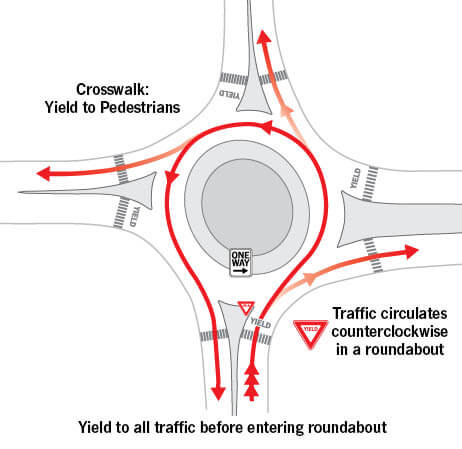13- Roundabouts
These are found in some areas to help ensure safe passage of traffic through an intersection without necessarily stopping the flow of traffic. Vehicles travel counterclockwise around a raised center island, with entering traffic yielding the right-of-way to circulating traffic. When entering the roundabout you must negotiate a sharp curve. Slow your speed to about 15 or 20 mph. Once in the roundabout, proceed to the appropriate exit. If there is more than one lane going in the direction, make sure you know where you want to go and are in the proper lane before entering. Do not change lanes or pass any vehicles. When using roundabouts:

This example shows the traffic movement patterns through a one-lane roundabout. The one-lane roundabout is known as one of the safest and most efficient types of intersections.
- Slow down as you approach the circle.
- Yield to any traffic in the circle. If another vehicle arrives at the same time, yield to the vehicle on your right.
- Yield to pedestrians and bicyclists.
- Yield to emergency vehicles in a roundabout.
- Enter the roundabout to the right, but steer to the left in a counterclockwise direction.
- Do not drive alongside large vehicles, such as trucks or buses, in a roundabout or traffic circle.
Be courteous and signal your intentions as you approach and drive through a traffic circle or roundabout.
- If you intend to turn right, signal “right” while approaching and until you have exited the traffic circle or roundabout.
- If you are traveling straight through, no signal is needed while approaching. However, signal “right” before the exit you want to take.
- If you intend to turn left, signal “left” on the approach to the traffic circle or roundabout. Once you have traveled three quarters of the way around the traffic circle or roundabout, signal “right” to take the exit.